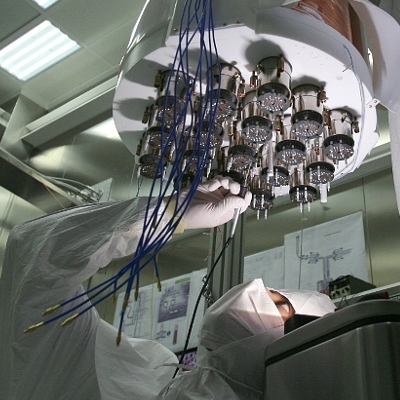
The DarkSide-50 experiment in operation at the Gran Sasso National Laboratory in Italy will report important new results on its search for dark matter,
at the UCLA Dark Matter 2018 conference and at the Lake Louise Winter Institute on February 21, 2018.
DarkSide-50 was designed as a search for high mass (>50 GeV/c2) Weakly Interacting Massive Particles (WIMPs) where the critical feature is background rejection. Analysis of a 530 day exposure has just been completed and the result is a convincing demonstration of the rejection capabilities of the technology. The discrimination achieved between natural radioactivity and nuclear recoils is a strong confirmation of the capabilities of the liquid argon technology. In addition to this achievement, a novel analysis of the ionization signal from low-energy events has been developed which demonstrates that the DarkSide-50 detector has outstanding capabilities in the search for lower mass (<10 GeV/c2) dark matter. These results encourage confidence that if a signal is eventually detected in a larger argon-based detector, like the upcoming DarkSide-20k, the signal will indeed be from something new in nature.
The Spokesperson of the DarkSide Collaboration, Cristiano Galbiati, stated: “This is the best way to start the adventure of the future experiment DarkSide-20k. The results of DarkSide-50 provide great confidence on our technological choices and on the ability to carry out a compelling discovery program for dark matter."
The heart of the DarkSide-50 apparatus is a two-phase liquid argon time projection chamber. Unique features of the detector are the active neutron veto and the use of low-radioactivity argon. The apparatus is located in Hall C of the underground laboratory of the Gran Sasso National Laboratories (LNGS) of the Italian National Institute for Nuclear Physics (INFN). The Experiment is a collaboration of institutions from Brazil, China, France, Italy, Poland, Spain, Russia, and the United States of America.
The DarkSide-50 Collaboration offers its profound gratitude to the LNGS and its staff for their invaluable technical and logistical support. Construction and operation of the DarkSide-50 detector has been supported by the U.S. National Science Foundation (NSF), the Italian Istituto Nazionale di Fisica Nucleare (INFN), the U.S. Department of Energy, the Russian Science Foundation, the Polish National Science Center (NCN) and the Foundation for Polish Science. We also acknowledge financial support from the French Institut National de Physique Nucléaire et de Physique des Particules (IN2P3), from the UnivEarthS Labex program of Sorbonne Paris Cité, and from the São Paulo Research Foundation (FAPESP).
DarkSide-20k
DarkSide-50 is a prototype for the DarkSide-20k experiment, which will expand the mass of the detector by a factor close to 1,000, greatly enhancing the capability for the discovery of dark matter.
The experiment is scheduled to enter operations at the end of 2021.
Scientists from the four world-leading LAr dark matter projects (ArDM at LSC, DarkSide-50 at LNGS, DEAP-3600 and MiniCLEAN at SNOLab) have agreed to join forces to carry out DarkSide-20k as a single next-generation LAr experiment at LNGS, forming the Global Argon Dark Matter Collaboration (GADMC). Since August 2017, DarkSide-20k is also an experiment officially and jointly supported by LNGS, LSC, and SNOLab. The same inclusive group of scientists also signed a Letter of Intent signaling their interest to continue the collaboration beyond DarkSide-20k to build a larger experiment, with a fiducial mass of a few hundreds of tonnes, capable to perform a final exploration of dark matter through the background floor caused by interaction of atmospheric neutrinos.
The Italian Government, the regional government of Sardinia and that of Abruzzo, all approved special Research & Innovation projects to develop the technologies required by DarkSide-20k. In particular, key to the success of the experiment is the extraction of argon from very deep wells in Colorado and its further distillation in a 350 meters tall cryogenic column installed in the Seruci mine in Sardinia. Furthermore, the silicon photosensors that will detect the light produced by interactions in the detector will be entirely produced in Italy and assembled in “Nuova Officina Assergi”, a new technological hub supported by Regione Abruzzo and hosted by LNGS.
“Years of research on liquid argon technology carried out in Italy are crowned with success by the results presented today”, explains Giuliana Fiorillo, responsible of the DarkSide program for INFN and a professor at Napoli University Federico II. “Our group includes 14 Universities from all over Italy, 12 divisions and 3 national laboratories of INFN”. “The DarkSide-20k project will allow us to lead future direct dark matter searches, as confirmed by the increasing number of researchers joining it from all over the world”, she concludes.


